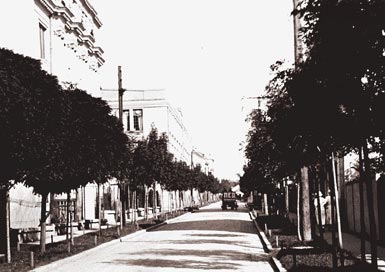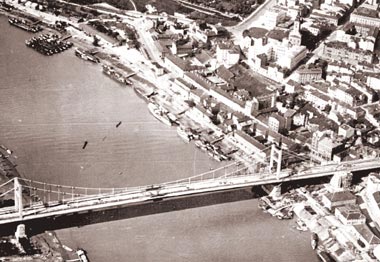Eternal Belgrade BELGRADE IN THE 30’S: A CHRONICLE OF AN INSPIRATION
The great rise of a wounded town
The capital of Serbia, destroyed the most among all European capitals, survived only because the calm building manpower triumphed over the rage of demolishers. One of the most important periods of building in newer history is the one between two world wars. Even if it lasted for a very short time, interrupted with new sufferings, the new modern Belgrade was finally born
 As well as Serbia, Belgrade suffered some difficult destruction during World War I. After the war was over, there was the restoration of industry and the town development. Belgrade experienced its true development in the 30's of the 20th century. As well as Serbia, Belgrade suffered some difficult destruction during World War I. After the war was over, there was the restoration of industry and the town development. Belgrade experienced its true development in the 30's of the 20th century.
In the first year of that decade there was a register made, and Belgrade, the capital, had 288,938 citizens (including Zemun and Pančevo). The so-called ”proper” Belgrade had 238, 775 citizens and the town was governed by the Head Office of Belgrade.
Everything that was old or Turkish was torn down in the proper part of town and a quick urbanistic development began while the suburbs still resisted. There were European influences present in architecture. The building of the Ministry of Traffic stands out, built at the corner of Nemanjina and Sarajevska Street, with a dome and a clock, from 1932. It was made after the project of Svetozar Jovanović. There was a cultural center (the Faculty of Mathematics) founding near Captain Miša's Residence, built in 1863 and in 1932, after the project of Petar Bajalović, the National University Kolarac was built.
The big suspension bridge over Sava towards Zemun was finished in 1934. Before the formal opening the security of the bridge was tested after 12 heavy weight trucks and 1000 horsemen crossed over it. The building of this bridge made possible the making of the Fairgrounds on the left bank of Sava, in 1937, after the project of Ignjat Popović. The bridge over the Danube toward Pančevo, for both highway and railroad transportation, was built and dedicated in 1935.
THE BIRTH OF THE METROPOLIS  Besides the National Bank established in 1833 and the State Bank established in 1862, there were 48 financial institutions, banks and savings banks in Belgrade in 1931. We should mention: the English Trading Bank, the Serbo-American Bank, the Serbo-French Bank (with the biggest capital), Associated Bank of Vienna and five branch offices of banks from Zagreb. The working capital was influenced by insurance offices: ”Šumadija”, ”Adria”, ”Rosija fonsijer” and ”Yugoslavia”. Besides the National Bank established in 1833 and the State Bank established in 1862, there were 48 financial institutions, banks and savings banks in Belgrade in 1931. We should mention: the English Trading Bank, the Serbo-American Bank, the Serbo-French Bank (with the biggest capital), Associated Bank of Vienna and five branch offices of banks from Zagreb. The working capital was influenced by insurance offices: ”Šumadija”, ”Adria”, ”Rosija fonsijer” and ”Yugoslavia”.
After World War I there were only three green markets in Belgrade: the Great Market near the present Student's Square, Cvetni Trg and Palilula Market. During 1926, when the Great Market was closed, new markets started working: on Zeleni venac, on Kalenić and in Gospodar Jovanova Street.
In the beginning of 1930 there were 4,488 artisans in Belgrade, mostly locksmiths, barbers, blacksmiths, tailors, hair stylists, builders, bakers... There were times where the state bought up small firms from private businessmen and made a good production. That is what happened with the sugar factory in Čukarica which was altered in 1932. The state bought up a slaughterhouse from a private worker on Viline Vode, near Pančevački Bridge. The agreement was signed in 1937.
Shoe factory ”Boston”, on Đeram, in King Aleksandar Street, became a miracle: with only 160 employees it produced more than 200,000 pairs of ”regular” and 300,000 pairs of ”military” shoes! There were factories of airplane motors and airplane parts, one in Rakovica and the other in Zemun.
There were 16 companies of textile industry, 22 companies of food industry, 26 companies of metal industry, 11 companies of furniture industry. There were 10 factories of chemical industry and one factory of paper industry. In 1939 there were about 107 companies with 50,000 workers in Belgrade!
On the left bank of Sava, on September 11, 1937, the new Belgrade Fair was opened. There were 833 exhibitors from which 99 are from all European countries. On the Fairgrounds that we already mentioned was a German concentration camp during World War II where many people from Belgrade lost their lives.
THE BEGINNING OF TOURISM  Arranging town's streets was a frequent subject on meetings of board member of the community. The modernization was interfered with works on the plumbing and the sewerage system. Makedonska Street was the first street in Belgrade which was paved with asphalt in 1911. After that, Skopljanska Street gets paved (the present Nušićeva Street) and then Knez-Mihailova Street... Arranging town's streets was a frequent subject on meetings of board member of the community. The modernization was interfered with works on the plumbing and the sewerage system. Makedonska Street was the first street in Belgrade which was paved with asphalt in 1911. After that, Skopljanska Street gets paved (the present Nušićeva Street) and then Knez-Mihailova Street...
Belgrade was declared to be a tourist town. The state gave free return train tickets to passengers who would spend at least ten days in Belgrade, in which 23 hotels (including Zemun), 33 restaurants, 433 taverns, 427 kafanas, 197 buffets, 412 national kitchens 318 inns and 239 dairy restaurants.
In the end of 1932 there were 13 streetcar lines in Belgrade, and the total length of streetcar tracks was 65 kilometers! The first streetcar for Zemun started working in 1935. He drove from the Parliament, over the new bridge, to the hotel ”Central” in Glavna Street. It had the number 14. It is interesting that then, just like now; there was no streetcar with the number 8.
The first telephone in Belgrade was installed in 1882, shortly before the World War II there were only 25 public phone booths in Belgrade. The most famous ones were at the entrance of Kalemegdan, at the railroad station, on Novo Cemetery, at the market in Jovanova Street, in the kafana ”Ruski car”, at Slavija Square...
In 1936 Belgrade had 68 hectares of green surfaces (parks, squares). It was also the time when the park besides ”Manjež” was arranged.
The Belgrade University included six faculties in 1931: law, medicine, philosophy, engineering, agriculture and theology (even women could study theology). Nine years later, in 1940, the town had 22 boy, 12 girl and two mixed high schools and 31 kindergartens.
In 1931, there were four public hospitals with 1,971 beds, 58 doctors and 147 nurses. There were 7 private sanatoriums which had 168 beds (each in every room!), 21 doctors and 32 nurses! Private practice was allowed so doctors worked in public hospitals in the morning and in their own offices in the afternoon.
(By Dragan Perić)
***
Having a bath
One of the greatest troubles of Belgrade citizens was that many people still didn't have their own bathroom at the time. They mostly bathed in several public bathhouses, paying a ticket.
***
Cobblestones
In 1932, Belgrade had 950 streets. Their total length was 350 kilometers. Nicely arranged cobblestones (wooden cubes in order to lessen the noise of wheels) covered 210 streets, regular cobblestones about 290 streets and about 450 streets was covered only by stamped dirt!
|
